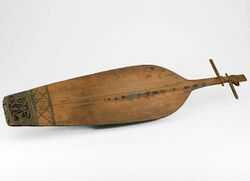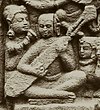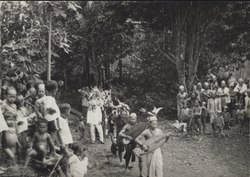Engineering:Sapeh
 The Tropenmuseum collection of Sapeh from East Kalimantan, c. 1900s | |
| String | |
|---|---|
| Other names | Sape, Sapeʼ, Sapek, Sapeik, Sapeq, Sampeh, Sampeʼ, Sampek, or Sampeq |
| Classification | String instrument |
| Hornbostel–Sachs classification | (Composite chordophones) |
| Developed | Tenggarong of East Kalimantan, Indonesia (mainly and originally) |
| Related instruments | |
| lute | |
| Musicians | |
|
List
| |
Sapeh, also spelt as Sape, Sapeʼ, Sapek, Sapeik, Sapeq, Sampeh, Sampeʼ, Sampek, or Sampeq (/sʌpɛʔ/) is the traditional string instrument of Java-origin that commonly developed in southern, eastern,[1][2] and central of Kalimantan. It is a wooden-base instrument with some simple strings attached, works similar way like the guitar(s).
Since 1950s, these string instruments from all regions all across Indonesian Archipelago has been officially recognized by the Indonesian government as one of the national Intangible Cultural Heritages of Indonesia in the domains of Traditional Skills and Crafts, Community Customs, Rites, and Celebrations, Performing Arts, as well as Traditions and Expressions of the Natives, and has been digitilized since at least 2010.[3][4][5][6][7] Its originality and development are also regulated and protected by both the national laws of the Republic of Indonesia and international laws.[8] Some notable native Dayak maestros of these musical instrument are also highly valued and respected by Indonesia and has been awarded in some Anugerah Kebudayaan (lit. Cultural Award(s)), such as mr. Arang from Bulungan[9] and mr. Irang Awai from Kutai.[10][11]
History
(photos above extracted from the digital ethnography collections of Tropenmuseum and KITLV in the Netherlands, photographed by Kassian Céphas in c. 1890-1891)
Besides generally traced through the archaeological study of carvings and bas-relief panels found in ancient temples of Java dates back to early 8th century era, according to proven native Kalimantan's manuscripts and inscriptions (mainly found in Banjar and Kutai Kertanegara), these string-based musical instrument commonly originated from eastern region of the island of Java and has been introduced to southern and eastern coastal regions of Kalimantan alongwith the Gamelan (percussion instruments) during the expansion of power of Singhasari kingdom (which later developed as Majapahit empire) in circa 12th to 13th century era. Some notable manuscripts are including the Nan Sarunai Usak Jawa (lit. Javanese power over Nan Sarunai) and Salasilah Kutai (lit. Genealogy of Kutai).[12][13] The etymological origin of Dayak sapeh, sapeʼ, sapek, sapeik, sapeq, sampeh, sampeʼ, sampek, or sampeq are also could be traced derived from Old Javanese sampe,[14] which literally means "contempt", "scorn", "scornful treatment", or "disrespect",[14] corresponds to the historical events as recorded in the Nan Sarunai Usak Jawa (lit. Javanese power over Nan Sarunai).[13]
It was first in prime performed in public during the Tenggarong's native festival of Erau in 13th century. Since then, the popularity Sapeh later spread to another regions of Kalimantan, even deep into the inland of the island in western of Tenggarong. During its development, the Sapeh also transformed as electrical-based string instrument and first patented in East Kalimantan.[15] Nowadays, it is played amongst the Dayak multiethnic community which could traced its ancestral origin in southern, central, and eastern regions of Kalimantan. In recent times, the northern and western regions of the island such as North Kalimantan,[9] West Kalimantan, the Malaya-occupied state of Sarawak are also gradually influenced by its neighbouring territory, the Sapeh was mainly introduced there by the natives of Kayan River.
Cultural significance
The performance of Sapeh was first publicly debut in the 13th century era during the Tenggarong's native festival of Erau. Its cultural values has always been connected to Java, thus the Sapeh sometimes used in religious activities of Kaharingan as well, which is a form of folk religion heavily influenced by Javanese Hinduism. Perceived as the means of ancestral and deities respect, the Sapeh also played with accompaniment of chants of folk songs.
In East Kalimantan particularly, the natives of Samarinda, West Kutai, and Mahakam Ulu have their own distinctive instrumental tones of Sapeh namely the Tubunsitun which characterized by its melodious gentle tone and Sakpakok which characterized by its fast and dynamic tone.[1]
See also
Note: This topic belongs to "Music" portal
References
- ↑ 1.0 1.1 "Sape, Alat Musik Kalimantan Mampu Berkolaborasi Dengan Musik Moderen" (in id). Dinas Komunikasi dan Informatika Provinsi Kalimantan Timur [Official Communication and Information Agency of East Kalimantan]. 2021. https://diskominfo.kaltimprov.go.id/budaya/sape-alat-musik-kalimantan-mampu-berkolaborasi-dengan-musik-moderen.
- ↑ "Sapeq Kalimantan Timur, Salah Satu Alat Musik Tradisional Dayak" (in id). Directorate of Cultural Heritage and Diplomacy, Directorate General of Culture of the Republic of Indonesia. 2019. https://kebudayaan.kemdikbud.go.id/ditwdb/sapeq-kalimantan-timur-salah-satu-alat-musik-tradisional-suku-dayak/.
- ↑ "Sape'" (in id). Ministry of Education and Culture of the Republic of Indonesia. 2010. https://warisanbudaya.kemdikbud.go.id/?newdetail&detailCatat=921.
- ↑ "Sape Kalimantan Barat" (in id). Ministry of Education and Culture of the Republic of Indonesia. 2017. https://warisanbudaya.kemdikbud.go.id/?newdetail&detailTetap=535.
- ↑ "Ta'a, Sapei, dan Sapaq" (in id). Ministry of Education and Culture of the Republic of Indonesia. 2017. https://warisanbudaya.kemdikbud.go.id/?newdetail&detailCatat=7501.
- ↑ "Sapeq" (in id). Ministry of Education and Culture of the Republic of Indonesia. 2018. https://warisanbudaya.kemdikbud.go.id/?newdetail&detailCatat=8657.
- ↑ "Sapeik" (in id). Ministry of Education and Culture of the Republic of Indonesia. 2018. https://warisanbudaya.kemdikbud.go.id/?newdetail&detailCatat=8660.
- ↑ "Law and Regulation of the Republic of Indonesia" (in en, id). World Intellectual Property Organization (WIPO). https://www.wipo.int/wipolex/en/members/profile/ID?collection=laws&subjectMatter=16&subjectMatter=1&subjectMatter=18.
- ↑ 9.0 9.1 "Arang, Maestro Alat Musik Sampe’" (in id). Directorate of Cultural Heritage and Diplomacy, Directorate General of Culture of the Republic of Indonesia. 2015. https://kebudayaan.kemdikbud.go.id/ditwdb/arang-maestro-alat-musik-sampe/.
- ↑ "Irang Awai: "Musik Menjaga Keseimbangan Alam"" (in id). Directorate of Cultural Heritage and Diplomacy, Directorate General of Culture of the Republic of Indonesia. 2017. https://kebudayaan.kemdikbud.go.id/ditwdb/irang-awai-musik-menjaga-keseimbangan-alam/.
- ↑ "Profil Penerima Anugerah Kebudayaan Indonesia 2017 Kategori Maestro Seni Tradisi : Irang Awai" (in id). Directorate of Cultural Heritage and Diplomacy, Directorate General of Culture of the Republic of Indonesia. 2017. https://kebudayaan.kemdikbud.go.id/ditwdb/profil-penerima-anugerah-kebudayaan-indonesia-2017-kategori-maestro-seni-tradisi-irang-awai/.
- ↑ Tromp, S.W. (2018-02-15). "Uit de Salasila van Koetei". Bijdragen tot de Taal-, Land- en Volkenkunde 37 (1): 1–108. doi:10.1163/22134379-90000277. ISSN 0006-2294.
- ↑ 13.0 13.1 K.S., Yakub (2021) (in id). Kidung Nan Sarunai Usak Jawa sebagai Sumber Inspirasi Penciptaan Musik Etnik 'Nansarunai'. Indonesian Art Institute of Yogyakarta.
- ↑ 14.0 14.1 Zoetmulder, P.J. (1982). "Old Javanese-English Dictionary" (in en, kaw). Old Javanese-English Dictionary. Koninklijk Instituut voor Taal-, Land- en Volkenkunde.
- ↑ "Undang-Undang Republik Indonesia Nomor 13 Tahun 2016 Tentang Paten" (in en, id). World Intellectual Property Organization (WIPO). 2016. https://www.wipo.int/wipolex/en/legislation/details/16392.
External links








